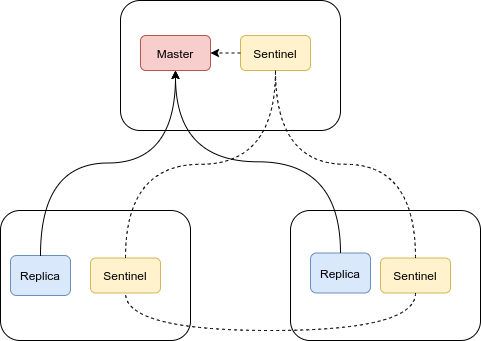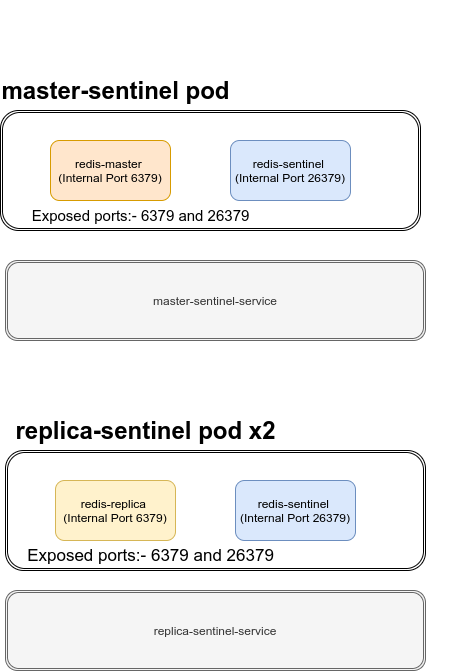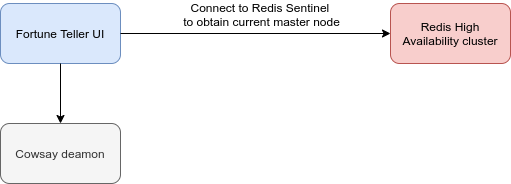Redis High Availability Solution using Redis Sentinel and docker
Posted on Dec 29, 2019
In this post we will configure the Redis high availability server using kubernetes. Below will be our final configuration for redis cluster.

For each block present above we will have seperate docker container. So we have below list of images
- master-sentinel: This will be single copy of container which will run resid master node and redis sentinel node
- replica-sentinel: This will be multiple(two in our case above) copy of container which will run redis replica node and redis sentinel node
Creating Docker image for master-sentinel
To configure master-sentinel image we need to two redis instances running, one with master configuration and one with sentinel configuration. So there will be two seperate configurations for both thes instances.
-
redis-master.conf
This configuration file will be used for starting Redis as a master node. As we are running the redis inside docker container it will aquire the local ip address assigned by Kubernetes, redis replica and redis sentinel processes on different container will need docker pod ip address to connect to this master node. So we need special configuration –cluster-announce-ip, –cluster-announce-port and –sentinel announce-ip, –sentinel announce-port that will be provided as a environment variable by Kubernetes deployment configuration. As we need master to listen connections from other docker machines we need to comment the line
bind 127.0.0.1in default configurations of redis.# bind 127.0.0.1Also protected mode should be turned off by commenting
protected-mode yes# protected-mode yesWe also need configuration added from command line so that process outside container will be able to connect to master node.
--cluster-announce-ip $MY_POD_IP --cluster-announce-port $MASTER_ANNOUNCE_PORT -
redis-sentinel.conf We will be configurting ht sentinel configuration from command line while starting the sentinel process from start script using below arguments
--sentinel announce-ip $MY_POD_IP --sentinel announce-port $SENTINEL_ANNOUNCE_PORT --sentinel monitor mymaster $MY_POD_IP $MASTER_ANNOUNCE_PORT 2 --sentinel down-after-milliseconds mymaster 30000 --sentinel parallel-syncs mymaster 1 --sentinel failover-timeout mymaster 180000Please note that we have hardcoded the master group
mymaster. We need to use this while connecting from client. -
start.sh
We need start script that will start both instances of redis(master and sentinel) with configuration discussed above.
redis-server /usr/local/etc/redis/redis.conf --cluster-announce-ip $MY_POD_IP --cluster-announce-port $MASTER_ANNOUNCE_PORTNote that we are using environment variable for
--cluster-announce-ipand--cluster-announce-portthis needs to be a part of kubernetes deployment cofigurationredis-server /usr/local/etc/redis/sentinel.conf --sentinel announce-ip $MY_POD_IP --sentinel announce-port $SENTINEL_ANNOUNCE_PORT --sentinel monitor mymaster $MY_POD_IP $MASTER_ANNOUNCE_PORT 2 --sentinel down-after-milliseconds mymaster 30000 --sentinel parallel-syncs mymaster 1 --sentinel failover-timeout mymaster 180000
Creating docker image for replica-sentinel
For creating image for replica-sentinel we need docker replica and docker sentinel running in same container and both should be connecting to redis master instance inside master-sentinel image. We will have configurations for redis-replica and redis-sentinel for the same.
-
redis-replicator.conf
We need redis-master to be able to connect to redis-replicator so we need below configuration commented
# bind 127.0.0.1Also we need to turn off protected mode by commenting below line
# protected-mode yesWe will also use below configuration from command line arguments
--replica-announce-ip $MY_POD_IP --replicaof $REDIS_MASTER_SERVICE_HOST $REDIS_MASTER_SERVICE_PORTWe need to pass $MY_POD_IP, $REDIS_MASTER_SERVICE_HOST and $REDIS_MASTER_SERVICE_PORT environment varialbles from kubernetes deployment configurations
-
redis-sentinel.conf
Sentinel configuration will be similar to the sentinel configuration inside master-sentinel, only different is instead of connecting to master node on the same machine it will read the master hostname from environment variable,
--sentinel monitor mymaster $REDIS_MASTER_SERVICE_HOST $REDIS_MASTER_SERVICE_PORT 2Rest of the configuration is same as sentinel in master-sentinel image.
-
start.sh
Finally we will have start.sh starting the replica and sentinel processes
Starting replica instance
redis-server /usr/local/etc/redis/redis-replicator.conf --replica-announce-ip $MY_POD_IP --replicaof $REDIS_MASTER_SERVICE_HOST $REDIS_MASTER_SERVICE_PORT &> /var/log/redis-replica.log &Starting sentinel instance
redis-server /usr/local/etc/redis/sentinel.conf --sentinel announce-ip $MY_POD_IP --sentinel announce-port $SENTINEL_ANNOUNCE_PORT --sentinel monitor mymaster $REDIS_MASTER_SERVICE_HOST $REDIS_MASTER_SERVICE_PORT 2 --sentinel down-after-milliseconds mymaster 30000 --sentinel parallel-syncs mymaster 1 --sentinel failover-timeout mymaster 180000
Kubernetes configuration for master-sentinel and replica-sentinel
For deploying the redis cluster on Kubernetes we need to create deployment and services as below

master-sentinel deployment
apiVersion: apps/v1
kind: Deployment
metadata:
name: redis-primary
namespace: web
labels:
app: redis-primary
spec:
selector:
matchLabels:
app: redis-primary
replicas: 1
template:
metadata:
labels:
app: redis-primary
spec:
containers:
- name: redis
image: spsarolkar/master-sentinel:1.0
resources:
requests:
cpu: 100m
memory: 100Mi
env:
- name: MY_POD_IP
valueFrom:
fieldRef:
fieldPath: status.podIP
- name: MASTER_ANNOUNCE_PORT
value: "6379"
- name: SENTINEL_ANNOUNCE_PORT
value: "26379"
ports:
- containerPort: 6379
name: redis-master
- containerPort: 26379
name: redis-sentinel
master-sentinel service
apiVersion: v1
kind: Service
metadata:
name: redis-primary
namespace: web
spec:
ports:
- port: 6379
targetPort: 6379
name: redis-master
- port: 26379
targetPort: 26379
name: redis-sentinel
selector:
app: redis-primary
replica-sentinel deployment
apiVersion: apps/v1
kind: Deployment
metadata:
name: redis-secondary
namespace: web
labels:
app: redis-secondary
spec:
selector:
matchLabels:
app: redis-secondary
replicas: 2
template:
metadata:
labels:
app: redis-secondary
spec:
containers:
- name: replica
image: spsarolkar/replica-sentinel:1.0
resources:
requests:
cpu: 100m
memory: 100Mi
env:
- name: REDIS_MASTER_SERVICE_HOST
value: redis-primary
- name: REDIS_MASTER_SERVICE_PORT
value: "6379"
- name: SENTINEL_ANNOUNCE_PORT
value: "26379"
- name: MY_POD_IP
valueFrom:
fieldRef:
fieldPath: status.podIP
ports:
- containerPort: 26379
name: redis-sentinel
replica-sentinel service
apiVersion: v1
kind: Service
metadata:
name: redis-secondary
namespace: web
spec:
ports:
- port: 26379
targetPort: 26379
selector:
app: redis-secondary
Connecting to redis from client application
To use this high availability cluster we need client capable of connecting to redis sentinel. In the example application we will use spring based configuration for connecting to redis sentinel.
I have created simple application using spring that has one deamon service and one front end service. The application block diagram is as below

-
Fortune Teller UI
This is simple spring boot application configured to use open id from google for authorization purpose. We have configured the HTTP session to connect to redis sentinel using below configuration
@Bean public LettuceConnectionFactory connectionFactory() { RedisSentinelConfiguration config = new RedisSentinelConfiguration() .master(appConfig.getRedisSentinelMasterGroup()) .sentinel(appConfig.getRedisMasterSentinelName(),appConfig.getRedisMasterSentinelPort()) .sentinel(appConfig.getRedisReplicaSentinelName(),appConfig.getRedisReplicaSentinelPort()); LettuceConnectionFactory connection = new LettuceConnectionFactory(config); return connection; }fortune-teller deployment
apiVersion: apps/v1 kind: Deployment metadata: name: fortune-teller namespace: web labels: app: fortune-teller spec: replicas: 3 selector: matchLabels: app: fortune-teller template: metadata: labels: app: fortune-teller spec: containers: - name: fortune-teller image: spsarolkar/fortune-teller:2.0 imagePullPolicy: IfNotPresent ports: - containerPort: 8080 name: http resources: limits: cpu: 500m memory: 700Mi requests: cpu: 100m memory: 300Mi env: - name: COWSAY_SERVER_NAME value: 'cowsay-deamon' - name: COWSAY_SERVER_PORT value: '8000' - name: REDIS_MASTER_NAME value: 'redis-primary' - name: MASTER_SENTINEL_PORT value: '26379' - name: REDIS_REPLICA_NAME value: 'redis-secondary' - name: REPLICA_SENTINEL_PORT value: '26379' - name: REDIS_SENTINEL_MASTER_GROUP value: 'mymaster'fortune-teller-service
apiVersion: v1 kind: Service metadata: name: fortune-teller-service namespace: web spec: type: LoadBalancer ports: - name: http protocol: TCP port: 80 targetPort: 8080 nodePort: 31737 selector: app: fortune-teller -
Cowsay deamon
This is rest API built using Django python framework. Front end will call rest service exposed by this deamon and will produce the fortune messages.
cowsay-deployment
apiVersion: apps/v1 kind: Deployment metadata: name: cowsay-deployment namespace: web labels: app: cowsay-deployment spec: replicas: 2 selector: matchLabels: app: cowsay-deployment template: metadata: labels: app: cowsay-deployment spec: containers: - name: cowsay-deployment image: spsarolkar/cowsay-deamon:1.0 imagePullPolicy: IfNotPresent ports: - containerPort: 8000 name: http resources: limits: cpu: 200m memory: 300Mi requests: cpu: 200m memory: 300Micowsay-service
apiVersion: v1 kind: Service metadata: name: cowsay-deamon namespace: web spec: ports: - name: http protocol: TCP port: 8000 targetPort: http selector: app: cowsay-deployment
I have deployed example application on minikube and is accesible from link http://gcp-kube-demo.sunilsarolkar.com/.
Source code available in Github repository https://github.com/spsarolkar/kube-redis-sample-setup.